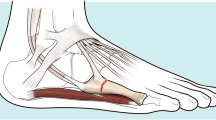Abstract
Introduction and purpose
Intramedullary screw fixation (ISF) of proximal fifth-metatarsal fractures is known as first treatment option in young, sports active patients. No study analyzed functional and biomechanical outcome before. Hypothetically ISF leads to (1) a high bony union rate within 12 weeks, (2) normal hindfoot eversion strength, and (3) normal gait and plantar pressure distribution.
Methods
Fourteen out of 22 patients were available for follow-up with an average follow-up of 42 months; clinical and radiological follow-up, and biomechanical evaluation by isometric muscular strength measurement (inversion, eversion strength) and dynamic pedobarography, comparing to the non-affected contralateral foot. Level of significance: 0.05.
Results
Subjective result: Excellent or good result in 14 patients, none fair or poor. AOFAS midfoot score: 100 points in 13 patients and 87 points in 1 patient. The same sports activity level (0–4) was reached in 13 out of 14 patients. Radiologic examination: consolidation after 6 weeks in 9 patients and after 12 weeks in another 4 patients, one partial union. Average maximal eversion strength 59 N (ratio to the contralateral foot: 0.92, not significant). Dynamic pedobarography showed ratios of 0.99–1.01 to the contralateral side for ground reaction force, ground peak time, peak pressure and contact area (not significant).
Interpretation
A very-high patient-satisfaction, a fast bony healing and complete return to sports were documented. Muscular strength measurement and dynamic pedobarography showed complete functional rehabilitation. Therefore, ISF in proximal fifth-metatarsal fractures can be recommended as a secure procedure.



Similar content being viewed by others
References
Low K, Noblin JD, Browne JE, Barnthouse CD, Scott AR (2004) Jones fractures in the elite football player. J Surg Orthop Adv 13(3):156–160
Fernandez Fairen M, Guillen J, Busto JM, Roura J (1999) Fractures of the fifth metatarsal in basketball players. Knee Surg Sports Trauma Arthrosc 7:373–377
Jones R (1902) Fracture of the base of the fifth metatarsal by indirect violence. Ann Surg 35:697–702
Horst F, Gilbert BJ, Glisson RR, Nunley JA (2004) Torque resistance after fixation of jones fractures with intramedullary screws. Foot Ankle Int 25(12):914–919
Valderrabano V, Pagenstert G, Horisberger M, Knupp M, Hintermann B (2006) Sports and recreation activity of ankle arthritis patients before and after total ankle replacement. Am J Sports Med 34(6):993–999
Kitaoka HB, Alexander IJ, Adelaar RS, Nunley JA, Myerson MS, Sanders M (1994) Clinical rating systems for the ankle-hindfoot, midfoot, hallux, and lesser toes. Foot Ankle Int 15(7):349–353
Valderrabano V, Hintermann B, Wischer T, Fuhr P, Dick W (2004) Recovery of the posterior tibial muscle after late reconstruction following tendon rupture. Foot Ankle Int 25:85–95
Porter DA, Duncan M, Meyer SJF (2005) Fifth metatarsal jones fracture fixation with a 4.5-mm cannulated stainless stell screw in the competitive and recreational athlete. Am J Sports Med 33(5):726–733
Portland G, Kelikian A, Kodros S (2003) Acute surgical management of Jones’ fracture. Foot Ankle Int 24(11):829–833
Reese K, Litsky A, Kaeding CC, Pedroza A, Shah N (2004) Cannulated screw fixation of Jones fractures. Am J Sports Med 32(7):1736–1742
Larson CM, Almekinders LC, Taft TN, Garrett WE (2002) Intramedullary screw fixation of Jones fractures: analysis of failure. Am J Sports Med 30(1):55–60
Clapper MF, O’Brien TJ, Lyons PM (1995) Fractures of the fifth metatarsal: analysis of a fracture registry. CORR 315:238–241
Lawrence SJ, Botte MJ (1993) Jones fractures and related fractures of the fifth metatarsal. Foot Ankle Int 14:358–364
TB Dameron Jr (1995) Fractures of the proximal fifth metatarsal: selecting the best treatment option. J Am Acad Orthop Surg 3(2):110–114
Smith JW, Arnoczky SP, Hersh A (1992) The intraosseus blood supply of the fifth metatarsal: implications for proximal fracture healing. Foot Ankle Int 13(3):143–152
Bong MR, Kummer FJ, Egol KA (2007) Intramedullary nailing of the lower extremity: biomechanics and biology. J Am Acad Orthop Surg 15(2):97–106
Josefsson PO, Karlsson M, Redlund-Johnell I, Wendeberg B (1994) Jones fracture. Surgical versus nonsurgical treatment. CORR 299:252–255
Lawrence SJ (2004) Technique tip: local bone grafting technique for Jones fracture management with intramedullary screw fixation. Foot Ankle Int 25(12):920–921
Husain ZS, DeFronzo DJ (2000) Relative stability of tension band versus two-cortes screw fixation for treating fifth metatarsal base avulsion fractures. J Foot Ankle Surg 39(2):89–95
Sarimo J, Rantanen J, Orava S, Alanen J (2006) Tension-band wiring for fractures of the fifth metatarsal located in the junction of the proximal metaphysis and diaphysis. Am J Sports Med 34(3):476–480
Arangio GA, Xiao D, Salathe EP (1997) Biomechanical study of stress in the fifth metatarsal. Clin Biomech 12(3):160–164
Donahue SW, Sharkey NA (1999) Stance phase of gait: implications for stress fractures. JBJS Am 81(9):1236–1244
Giordano AR, Ferkel RD (2004) Strength analysis of intraosseous wire fixation for avulsion fractures of the fifth metatarsal base. J Foot Ankle Surg 43(4):225–230
Moshirfar A, Campbell JT, Molloy S, Jasper LE, Belkoff SM (2003) Fifth metatarsal tuberosity fracture fixation: a biomechanical study. Foot Ankle Int 24(8):630–633
Vertullo CJ, Glisson RR, Nunley JA (2004) Torsional strains in the proximal fifth metatarsal: implications for Jones and stress fracture management. Foot Ankle Int 25(9):651–656
Valderrabano V, von Tscharner V, Nigg B, Hintermann B, Goepfert B, Fung TS, Frank CB, Herzog W (2006) Lower leg muscle atrophy in ankle osteoarthritis. J Orthop Res 24(12):2159–2169
Author information
Authors and Affiliations
Corresponding author
Rights and permissions
About this article
Cite this article
Leumann, A., Pagenstert, G., Fuhr, P. et al. Intramedullary screw fixation in proximal fifth-metatarsal fractures in sports: clinical and biomechanical analysis. Arch Orthop Trauma Surg 128, 1425–1430 (2008). https://doi.org/10.1007/s00402-008-0709-4
Received:
Published:
Issue Date:
DOI: https://doi.org/10.1007/s00402-008-0709-4




